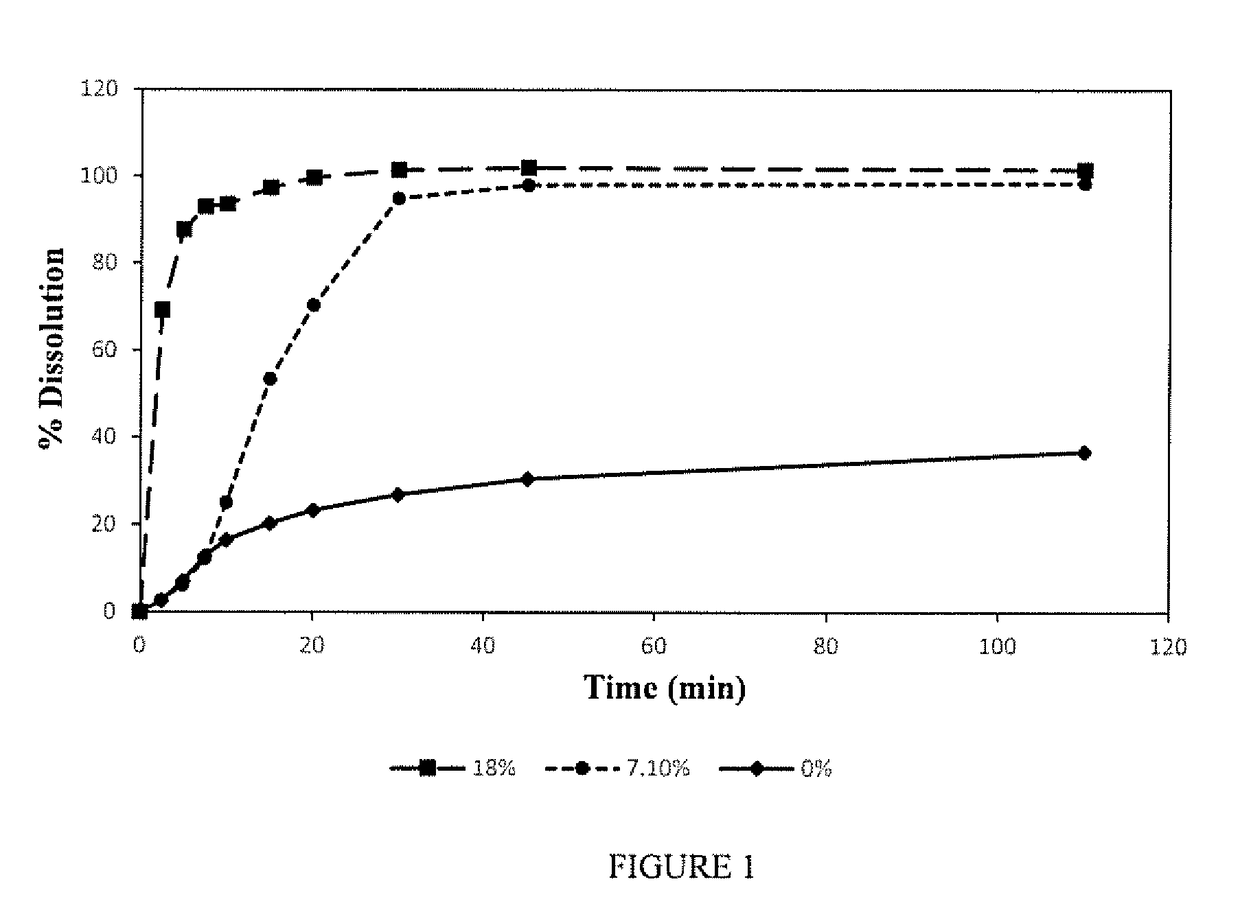Solid oral film dosage forms and methods for making same
- Summary
- Abstract
- Description
- Claims
- Application Information
AI Technical Summary
Benefits of technology
Problems solved by technology
Method used
Image
Examples
example 1
[0039]About 0.1 to about 5 g of a pharmaceutically active ingredient is dissolved in 11-29 ml of ethyl alcohol. To the resulting solution, 0.1 g of aspartame, 1.0 to 2.9 g of menthol / triacetine and 0.1-1.0 g of propylene glycol caprilate are added. Optionally 0.1 to 1 g of polysorbate 80 and 0.1 to 1 g of polyoxyglyceride is added to the mixture. After one hour of stirring at high speed, 4 to 6 g of polyvinyl pyrrolidone and 0.1 to 0.5 g of pregelatinized modified starch are added and the mixture is stirred until homogenous. About 2.0 to 3.0 g of hydroxypropyl cellulose is added to the mixture. The blend is stirred for one hour before adding 0.02-0.08 g of colorant Yellow# 6. Mixing is continued until a homogenous polymeric solution is obtained. About 25-35% of the solution is coated onto a suitable cm Tier material, for example non-siliconized, polyethylene-coated kraft paper, using conventional coating / drying equipment. Coating gap and web speed are adjusted to achieve a dry film ...
example 2
[0040]About 0.3 g of a pharmaceutically active ingredient is dissolved in 2 ml to 15.0 ml of ethyl alcohol and 40 to 56 ml of water. To the solution, 0.08 g of Talin, 0.15 g of aspartame, 2.0 g to 3.5 g of 10% menthol / triethyl citrate, 0.5 g to 1.5 g of polysorbate 80 were added and the resulting mixture is stirred at high speed for 1.5 hours. Optionally, the mixture can include 0.1 to 1.0 g of polyethyleneoxide and / or 0.2 g to 0.5 g of sodium EDTA. From 8.0 g to 10.0 g of polyvinyl pyrrolidone is added and the mixture is stirred for one more hour. From 2.0 g to 4.5 g of hydroxypropyl methyl cellulose type E15 was added to the mixture. Optionally 0.5 g to 4.5 g of high molecular weight polyoxyethylene is added and the blend is stirred for one hour before adding 0.04 g of colorant Yellow # 6 and 0.5 g of mint oil. Mixing is continued until a homogenous polymeric solution is obtained. The solution is coated onto a suitable carrier material, and dried at 15° C. for a time sufficient to...
example 3
[0041]About 2.8 g of a pharmaceutically active ingredient is dissolved in up to 4.5 ml of ethyl alcohol and from 31 ml to 35 ml of water. To the mixture, 0.5 g of ascorbic acid, 0.5 g of aspartame, 1.5 to 3 g of 14% menthol / triacetine, up to 0.5 g of polysorbate 20, and optionally 0.7 g of propylene glycol caprilate are added and the resulting mixture is stirred at high speed for 1 hour. From 6.0 to 8.0 g of polyvinyl pyrrolidone, 1.0 g to 2.5 g of polyethylene oxide 8000, and 0.2 g of pregelatinized modified starch are added to the mixture and stirred until it is homogenous. 1.0 g to 4.0 g of hydroxypropyl cellulose is added to the mixture. The blend is stirred for 1 hour before adding 0.04 g of colorant Blue#1. Mixing is continued until a homogenous polymeric solution is obtained. The solution is coated onto a suitable carrier material, and dried.
PUM
| Property | Measurement | Unit |
|---|---|---|
| Temperature | aaaaa | aaaaa |
| Length | aaaaa | aaaaa |
| Fraction | aaaaa | aaaaa |
Abstract
Description
Claims
Application Information
 Login to View More
Login to View More - R&D
- Intellectual Property
- Life Sciences
- Materials
- Tech Scout
- Unparalleled Data Quality
- Higher Quality Content
- 60% Fewer Hallucinations
Browse by: Latest US Patents, China's latest patents, Technical Efficacy Thesaurus, Application Domain, Technology Topic, Popular Technical Reports.
© 2025 PatSnap. All rights reserved.Legal|Privacy policy|Modern Slavery Act Transparency Statement|Sitemap|About US| Contact US: help@patsnap.com



